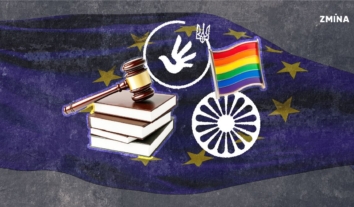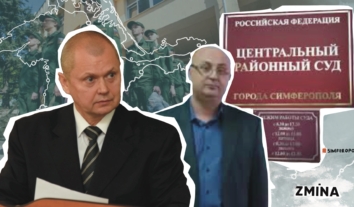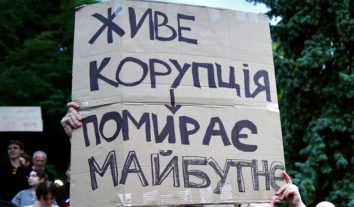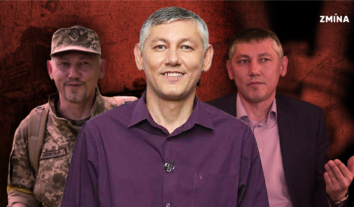Odesa May 2 Investigation: A Failed Test for Ukrainian Justice
While visiting Odesa on April 10, President Petro Poroshenko called ensuring an objective investigation of the events in Odesa on May 2, 2014 “a test of justice for Ukraine’s law enforcement bodies”. It is a test that unfortunately they have thus far failed. This is especially galling given the need to counter Russia’s intensive propaganda campaign which falsely presents the disturbances and fire as a ‘massacre’.
Poroshenko is undoubtedly correct that full investigations take time. However where people are held in custody, there must be clarity as to the grounds in each specific case. Almost exactly a year on, there is none. Of the 22 people now on trial, of whom 11 are in custody, virtually all are facing identical charges of taking part in disturbances – as did hundreds of others who have not been charged. At the same time Serhiy Khodiyak who is suspected of killing one person and injuring another is presently at liberty, with the material having only just been passed to the court. Since the 22 defendants are all pro-federalism [pro-Russian] activists, while Khodiyak is from the pro-Ukrainian unity, pro-EuroMaidan camp, the lack of symmetry cannot fail to be of concern.
One year ago
Six people died of gunshot wounds and many others were injured during disturbances in the centre of Odessa on May 2, and a further 42 people died as a result of a fire in the Trade Union building on Kulikovo Pole.
It is known that the initial violence was deliberately provoked by a group of aggressive pro-federalism activists who were part of the protest tent camp on Kulikovo Pole. Knowing who started it, however, is of limited importance since weapons, including firearms, were used by both pro-federalism and pro-unity activists, and the victims of the earlier disturbances included activists from both camps. All 42 people who died in the fire were pro-federalism supporters meaning that the number of victims from one side of the conflict far outweighs the other. This makes it especially undesirable to have delays or irregularities in the investigation and heightens the importance of holding those responsible to answer.
The official version
Poroshenko’s interview was listened to with some bemusement by Vladislav Serdyuk, one of the members of the May 2 Group. This civic initiative is made up of journalists, scientists and others who have reacted to the absence of transparency and openness from the authorities by carrying out their own investigation. Serdyuk calls the information presented by Poroshenko a “new, original version of the course of events”, quite unlike any of the others.
According to this new version, the main organizer of the bloody events was Dmytro Fuchedzhy, deputy head of the Odesa Regional Police, who fled shortly after the events and is now believed to be in Transnistria, the self-proclaimed and Moscow-backed breakaway ‘state’ between Ukraine and Moldova. The aim, so the version goes, was to get pro-federalism and pro-unity activists killing each other and thus provoke an explosive situation in the region. The direct organizers fled and are now outside the country.
Serdyuk calls the version “very attractive and convenient, but improbable”. Nobody is denying that Fuchedzhy supported the pro-federalism camp on Kulikovo Pole and played a role, but the latter should not be exaggerated.
Serdyuk suggested that it was the Interior Ministry that was misleading the President, but the Prosecutor General’s Office [PGO] report, posted on April 22, also focuses on Fuchedzhy.
The PGO report is critical of the police which failed to properly protect public order by not preventing the clashes that then escalated to a point beyond police control, with 18 people receiving gunshot wounds, 6 proving fatal.
Investigation into this failure has resulted in criminal charges being brought against Fuchedzhy ”for exceeding his power and negligence which was expressed in inadequate organization of police forces in protecting public order, this resulting in mass riots”.
Criminal charges have also been laid against three police officers, with a court trial said to be underway. No more detail is provided in the report, however the May 2 Group believes that this refers to three police officers charged with negligence for releasing over 60 pro-federalism activists held after the disturbances. They were released on May 4 after a crowd gathered outside the holding centre and threatened to storm it.
The second part of the investigation is said to be in establishing the organizers and active participants in the mass riots “who carried out attacks, used weapons and other items to cause physical injury.” The court trial of 22 defendants is mentioned here, as well as the investigation into one person – presumably Khodiyak – accused of murder. One other investigation has been terminated because the suspect has died (Mykola (Volkov), whose photo is often used in Russian propaganda is probably meant – detailshere). “10 other active participants and organizers of mass riots have been placed on the wanted list”.
The third part of the investigation is into the causes of death of the 42 people who died in the Trade Union building or jumped to their death. This confirms that all deaths were due to the fire, and refutes earlier claims that chloroform or similar was used. No evidence was found to suggest that the fire was planned, and Molotov cocktails were hurled by both sides – both into and from the building – making it impossible to ascertain which set the barricades alight. The findings with respect to the fire itself are essentially the same as those provided by the May 2 Group’s specialist Vladislav Balinsky which can be found here.
The PGO, however, then mentions that the investigators established negligence by officials of the Odessa Regional Emergencies Department in not sending the necessary fire engines. We are told only that “the investigation is being carried out by the Interior Ministry’s Central Investigation Department”, and then that the large number of victims was due to the mass riots.
The emergency services were informed immediately – at 19.31 and from then on repeatedly – about the fire, but appeared only at around 20.10. This was surely the cause of a very large number of the deaths, and something that should not take a year to ascertain.
Unasked, or just unanswered?
It is undoubtedly true that a number of people directly involved in the disturbances have fled to areas under Russian or Kremlin-backed militant control, with these including Vitaly Budko [‘Botsman’] seen on video footage shooting at pro-unity activists from behind police cordons and one top police official, Fuchedzhy. There are multiple questions, however, which are not answered by laying the responsibility on Fuchedzhy, with three police officers charged with a separate occasion slipped in for good measure.
The SBU [Security Service] and Interior Ministry had informed of likely disturbances and provocation in both eastern and southern oblasts from May 1 to 10. The Odessa regional police were also fully aware of planned actions prior to a football match between Chernomorets and Metallist on May 2.
An action plan to deal with likely disturbances entitled Khvylya [Wave] had been drawn up in advance and was actually signed just hours before the disturbances began. It needed to be registered, however, in order to be carried out, yet this did not happen. Questions need to be asked as to why not. There are numerous other unexplained details that day, some of which the May 2 Group has tried to answer, while being constantly hampered by the lack of openness about information of undoubted public importance.
Most disturbing in all of this, however, is the ongoing trial of 22 men on fundamentally flawed charges, with 11 having been deprived of their liberty for almost a year. There is serious evidence against only one defendant – Serhiy Dolzhenkov – who is alleged to have organized and led the attack on the pro-Ukrainian unity march, yet the indictment provides no detailed information about what he is specifically accused of having done. There seems to be no real evidence against the other defendants with the same formulation used against each of them. All are said to have: “taken an active part in mass disturbances, namely throwing stones, sticks and other items at people in order to cause damage to life and health, and resisted police officers”.
Dolzhenkov is reported to have already lodged a complaint with the European Court of Human Rights over his treatment. It seems likely that other applications will follow.
The message from Poroshenko’s April 10 interview about Odessa having withstood a grave threat to its stability is probably one many Odesans would endorse. They view the tragic events as having shaken their city and removed the likelihood that Odesa would follow the same fate as the Donetsk and Luhansk oblasts.
There are numerous challenges to that fragile stability with many, like the so-called ‘People’s Council of Bessarabia’ and fake protests, suggesting Russian involvement. There are other threats, however, and one must surely be failure by Ukraine’s post-Maidan government to carry out a full, objective and honest investigation into tragedies like Odesa May 2, and punish only those genuinely guilty of offences. The bitterness, sense of betrayal and of alienation generated by miscarriages of justice will divide Ukrainians just as effectively as Russian lies about a ‘massacre’.
Halya Coynash, the Kharkiv Human Rights Protection Group








